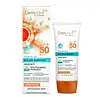What's inside
What's inside
 Key Ingredients
Key Ingredients

 Benefits
Benefits

 Concerns
Concerns

 Ingredients Side-by-side
Ingredients Side-by-side

Water
Skin ConditioningDibutyl Adipate
EmollientC12-15 Alkyl Benzoate
AntimicrobialDiethylamino Hydroxybenzoyl Hexyl Benzoate
UV FilterPolysilicone-15
UV FilterSilica
AbrasivePolyglyceryl-6 Stearate
EmollientGlycerin
HumectantNiacinamide
SmoothingSynthetic Fluorphlogopite
Methylene Bis-Benzotriazolyl Tetramethylbutylphenol
UV FilterBis-Ethylhexyloxyphenol Methoxyphenyl Triazine
Skin ConditioningEthylhexyl Triazone
UV AbsorberPolyglyceryl-6 Behenate
Emulsion StabilisingCetearyl Alcohol
EmollientPanthenol
Skin ConditioningDipropylene Glycol
HumectantGlyceryl Stearate
EmollientHydroxyacetophenone
AntioxidantAcrylates/C10-30 Alkyl Acrylate Crosspolymer
Emulsion StabilisingTromethamine
BufferingDecyl Glucoside
CleansingCaprylyl Glycol
EmollientAllantoin
Skin ConditioningAdenosine
Skin ConditioningDisodium EDTA
Xanthan Gum
EmulsifyingDipotassium Glycyrrhizate
HumectantCeramide NP
Skin ConditioningGlycine Soja Oil
EmollientButylene Glycol
HumectantPolyglyceryl-3 Diisostearate
EmulsifyingOryza Sativa Germ Extract
EmollientOryza Sativa Extract
AbsorbentFragaria Vesca Fruit Extract
AstringentWater, Dibutyl Adipate, C12-15 Alkyl Benzoate, Diethylamino Hydroxybenzoyl Hexyl Benzoate, Polysilicone-15, Silica, Polyglyceryl-6 Stearate, Glycerin, Niacinamide, Synthetic Fluorphlogopite, Methylene Bis-Benzotriazolyl Tetramethylbutylphenol, Bis-Ethylhexyloxyphenol Methoxyphenyl Triazine, Ethylhexyl Triazone, Polyglyceryl-6 Behenate, Cetearyl Alcohol, Panthenol, Dipropylene Glycol, Glyceryl Stearate, Hydroxyacetophenone, Acrylates/C10-30 Alkyl Acrylate Crosspolymer, Tromethamine, Decyl Glucoside, Caprylyl Glycol, Allantoin, Adenosine, Disodium EDTA, Xanthan Gum, Dipotassium Glycyrrhizate, Ceramide NP, Glycine Soja Oil, Butylene Glycol, Polyglyceryl-3 Diisostearate, Oryza Sativa Germ Extract, Oryza Sativa Extract, Fragaria Vesca Fruit Extract
Water
Skin ConditioningGlycerin
HumectantSodium Acrylates Crosspolymer-2
AbsorbentButylene Glycol
HumectantPolysilicone-11
Dimethicone
EmollientButyl Methoxydibenzoylmethane
UV AbsorberEthylhexyl Methoxycinnamate
UV AbsorberHydrolyzed Jojoba Esters
Skin ConditioningMethylene Bis-Benzotriazolyl Tetramethylbutylphenol
UV FilterSaccharide Isomerate
HumectantOctocrylene
UV AbsorberPhenoxyethanol
PreservativeChlorphenesin
AntimicrobialDecyl Glucoside
CleansingPolysorbate 40
EmulsifyingLecithin
EmollientDisodium EDTA
Polysorbate 20
EmulsifyingLaureth-12
EmulsifyingBenzophenone-3
UV AbsorberTitanium Dioxide
Cosmetic ColorantHamamelis Virginiana Water
AstringentAloe Barbadensis Leaf Juice
Skin ConditioningPropylene Glycol
HumectantCitric Acid
BufferingSodium Citrate
BufferingXanthan Gum
EmulsifyingEthylhexylglycerin
Skin ConditioningPolygonum Aviculare Extract
EmollientMelanin
Skin ProtectingPalmitoyl Tripeptide-5
Skin ConditioningPotassium Sorbate
PreservativeSodium Benzoate
MaskingPentylene Glycol
Skin ConditioningBenzoic Acid
MaskingWater, Glycerin, Sodium Acrylates Crosspolymer-2, Butylene Glycol, Polysilicone-11, Dimethicone, Butyl Methoxydibenzoylmethane, Ethylhexyl Methoxycinnamate, Hydrolyzed Jojoba Esters, Methylene Bis-Benzotriazolyl Tetramethylbutylphenol, Saccharide Isomerate, Octocrylene, Phenoxyethanol, Chlorphenesin, Decyl Glucoside, Polysorbate 40, Lecithin, Disodium EDTA, Polysorbate 20, Laureth-12, Benzophenone-3, Titanium Dioxide, Hamamelis Virginiana Water, Aloe Barbadensis Leaf Juice, Propylene Glycol, Citric Acid, Sodium Citrate, Xanthan Gum, Ethylhexylglycerin, Polygonum Aviculare Extract, Melanin, Palmitoyl Tripeptide-5, Potassium Sorbate, Sodium Benzoate, Pentylene Glycol, Benzoic Acid
 Reviews
Reviews

Ingredients Explained
These ingredients are found in both products.
Ingredients higher up in an ingredient list are typically present in a larger amount.
Butylene Glycol (or BG) is used within cosmetic products for a few different reasons:
Overall, Butylene Glycol is a safe and well-rounded ingredient that works well with other ingredients.
Though this ingredient works well with most skin types, some people with sensitive skin may experience a reaction such as allergic rashes, closed comedones, or itchiness.
Learn more about Butylene GlycolDecyl Glucoside is a glucose-based surfactant and emulsion stabilizer. It is created by reacting glucose with the fatty acids from plants.
Surfactants help clean the skin by trapping oil, sebum, and dirt to be washed away. As an emulsion stabilizer, it stabilizes the ingredients in a product by preventing them from separating.
This ingredient is biodegradable and non-toxic. This ingredient is commonly found in baby shampoos.
Decyl Glucoside is sometimes used to stabilize the UV filter Tinosorb.
Learn more about Decyl GlucosideDisodium EDTA plays a role in making products more stable by aiding other preservatives.
It is a chelating agent, meaning it neutralizes metal ions that may be found in a product.
Disodium EDTA is a salt of edetic acid and is found to be safe in cosmetic ingredients.
Learn more about Disodium EDTAGlycerin is already naturally found in your skin. It helps moisturize and protect your skin.
A study from 2016 found glycerin to be more effective as a humectant than AHAs and hyaluronic acid.
As a humectant, it helps the skin stay hydrated by pulling moisture to your skin. The low molecular weight of glycerin allows it to pull moisture into the deeper layers of your skin.
Hydrated skin improves your skin barrier; Your skin barrier helps protect against irritants and bacteria.
Glycerin has also been found to have antimicrobial and antiviral properties. Due to these properties, glycerin is often used in wound and burn treatments.
In cosmetics, glycerin is usually derived from plants such as soybean or palm. However, it can also be sourced from animals, such as tallow or animal fat.
This ingredient is organic, colorless, odorless, and non-toxic.
Glycerin is the name for this ingredient in American English. British English uses Glycerol/Glycerine.
Learn more about GlycerinMethylene Bis-Benzotriazolyl Tetramethylbutylphenol (Tinosorb M) is a hybrid and broad-spectrum UV ingredient. It is both a UV absorber and filter.
UV absorbers are an agent that absorbs UV rays. They protect your skin by using chemical reactions to convert UV rays into heat and energy. UV filters physically reduce the amount of UV rays from reaching your skin.
Tinosorb M covers a range of 280-400 nm and is photostable. This ingredient is neither oil or water soluble.
Tinosorb M is not available in the US. However, it is available in the EU and Asia.
It's sister, Tinosorb S, is set to be approved in the US by late 2025 (fingers crossed!).
Learn more about Methylene Bis-Benzotriazolyl TetramethylbutylphenolWater. It's the most common cosmetic ingredient of all. You'll usually see it at the top of ingredient lists, meaning that it makes up the largest part of the product.
So why is it so popular? Water most often acts as a solvent - this means that it helps dissolve other ingredients into the formulation.
You'll also recognize water as that liquid we all need to stay alive. If you see this, drink a glass of water. Stay hydrated!
Learn more about WaterXanthan gum is used as a stabilizer and thickener within cosmetic products. It helps give products a sticky, thick feeling - preventing them from being too runny.
On the technical side of things, xanthan gum is a polysaccharide - a combination consisting of multiple sugar molecules bonded together.
Xanthan gum is a pretty common and great ingredient. It is a natural, non-toxic, non-irritating ingredient that is also commonly used in food products.
Learn more about Xanthan Gum